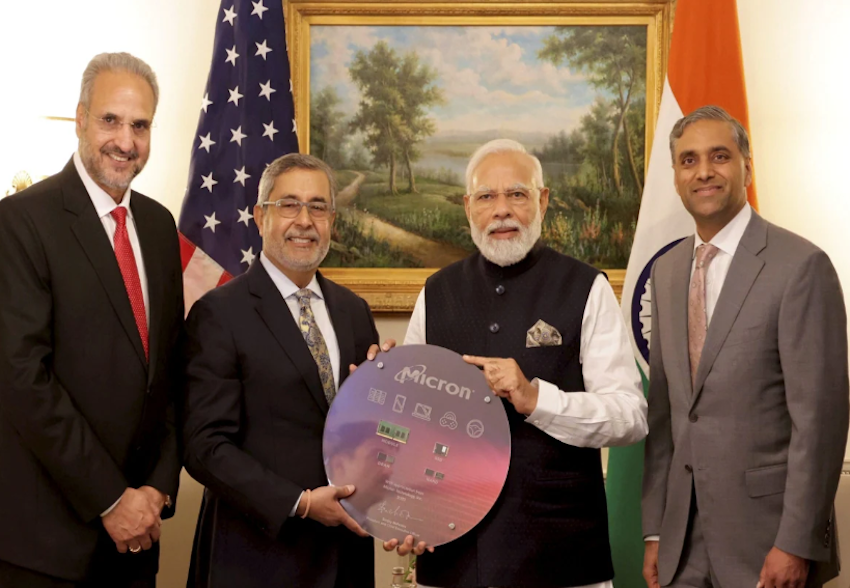
From Silicon Valley to Gujarat: Micron’s Billion-Dollar Bet on India’s Chip Dreams
In a move that sent ripples across the tech world, Silicon Valley giant Micron Technology made a bold gambit in 2023, planting its flag not in the familiar fields of California, but in the heart of Gujarat, India. With a billion-dollar investment, Micron is betting on India’s burgeoning tech ambitions, aiming to transform the nation from a chip consumer to a chip creator. This is not just a corporate maneuver; it’s a potential game-changer for India’s semiconductor dreams, a chance to leapfrog from being a passive player to a significant force in the global tech landscape.
Imagine a bustling factory humming to life in the arid plains of Gujarat, spitting out the tiny brains that power our smartphones, laptops, and cars. This is the vision Micron paints, a vision where India, long reliant on imports for its chip needs, finally takes control of its own tech destiny. The potential benefits are immense: thousands of new jobs, a surge in domestic innovation, and a strategic shift in India’s economic and technological independence.
But this is no easy feat. India’s semiconductor journey is still in its nascent stages, plagued by infrastructure bottlenecks, a nascent talent pool, and a complex regulatory environment. Micron’s gamble, however, could be the catalyst for change. Its investment will not only bring much-needed capital but also cutting-edge technology and expertise, paving the way for other players to follow suit.
The journey from Silicon Valley to Gujarat is not just a geographical shift; it’s a leap of faith. Micron’s gamble is a testament to India’s growing potential, a recognition of the talent and ambition simmering beneath the surface. This is not just about chips; it’s about building an ecosystem, a future where India stands shoulder-to-shoulder with the tech giants of the world.
The road ahead will be challenging, but the potential rewards are too great to ignore. As Micron sows its seeds in the fertile soil of Indian innovation, the world watches with bated breath. Will this billion-dollar bet blossom into a semiconductor powerhouse, or will it wither under the weight of ambition? Only time will tell, but one thing is certain: India’s chip dreams are no longer confined to the realms of fantasy. They are taking root, and Micron’s gamble has just given them a vital shot of growth.
India’s Semiconductor Leap: How Micron’s Investment Could Reshape the Nation’s Tech Landscape
India, a land of vibrant colors and ancient traditions, is poised for a groundbreaking technological transformation. In a move that echoes through the silicon valleys of the world, tech giant Micron Technology has placed a billion-dollar bet on India’s semiconductor ambitions. This isn’t just an investment; it’s a potential catalyst for India’s leap from a chip consumer to a chip creator, reshaping the nation’s tech landscape in profound ways.
Imagine factories humming with the intricate ballet of chip fabrication, churning out the tiny brains that power our modern lives. This is the future Micron envisions for India, a future where the nation sheds its dependence on foreign imports and takes control of its own technological destiny. The potential benefits are staggering: thousands of high-skilled jobs, a surge in domestic innovation, and a strategic shift towards economic and technological independence.
But this journey won’t be paved with rose petals. India’s semiconductor industry is still in its infancy, grappling with infrastructure gaps, a nascent talent pool, and a complex regulatory maze. Micron’s investment, however, is a game-changer. It infuses much-needed capital and cutting-edge technology into the system, paving the way for other players to follow suit. This influx of expertise will not only bolster domestic production but also foster a vibrant ecosystem of innovation and collaboration.
Micron’s gamble is a testament to India’s burgeoning potential. It recognizes the talent and ambition simmering beneath the surface, the spirit of a nation eager to claim its rightful place in the global technological arena. This isn’t just about chips; it’s about building a robust ecosystem where Indian ingenuity thrives and propels the nation towards self-reliance.
The road ahead will be far from smooth. Infrastructure bottlenecks need to be tackled, skilled professionals need to be nurtured, and regulatory hurdles need to be streamlined. But Micron’s investment has set the stage for a collaborative effort – government, industry, and academia working hand-in-hand to overcome these challenges.
As Micron sows the seeds of technological transformation in Gujarat, the world watches with keen anticipation. Will India’s chip dreams blossom into a thriving tech powerhouse, or will they wither under the weight of ambition? One thing is certain: the game has changed. India is no longer a passive observer in the global tech race; it’s an active participant, fueled by a billion-dollar bet and the unwavering spirit of innovation.
This is India’s semiconductor leap, and it’s just the beginning of a remarkable journey.
More Than Chips: The Economic and Strategic Implications of Micron’s Move to India
While Micron’s billion-dollar investment in India’s semiconductor industry might appear solely focused on tiny silicon chips, its implications reach far beyond the factory floor. This move has the potential to rewrite the script on India’s economic and strategic landscape, with ripples extending across the global tech scene.
Economically, Micron’s gamble injects a much-needed shot of adrenaline into India’s tech sector. Thousands of high-skilled jobs will blossom, fueling domestic innovation and fostering a robust ecosystem of chip-related industries. This translates to a surge in GDP, increased exports, and a significant reduction in India’s reliance on imported chips. But the benefits go beyond immediate gains. This move lays the groundwork for a self-reliant tech future, where India can develop its own chip designs and manufacture cutting-edge technology, reducing dependence on foreign players and strengthening its position in the global tech supply chain.
Strategically, Micron’s move carries significant weight. It chips away at the dominance of established tech giants, particularly those in geopolitically sensitive regions. India, with its vast talent pool and stable government, offers a secure and reliable alternative, potentially disrupting existing power dynamics in the semiconductor world. This shift towards diversification and resilience strengthens India’s strategic autonomy and bolsters its self-reliance in critical technological domains.
However, the road ahead is not without its challenges. India needs to address infrastructure bottlenecks, bridge the talent gap, and streamline regulations to create an environment conducive to semiconductor growth. This requires a concerted effort from government, industry, and educational institutions, ensuring that Micron’s investment is not a solitary spark in the dark, but the catalyst for a sustained technological revolution.
Micron’s move to India is more than just a business deal; it’s a strategic leap forward for a nation hungry for technological independence. It holds the promise of economic prosperity, strategic autonomy, and a reshaping of the global tech landscape. Whether India can seize this opportunity and turn its chip dreams into reality remains to be seen, but one thing is certain: the game has changed, and the world is watching with bated breath.
Building a Domestic Champion: Can Micron’s Investment Spark a Semiconductor Revolution in India?
The dusty plains of Gujarat, India, are witnessing a potential silicon revolution. Micron Technology’s billion-dollar investment in a chip assembly and test facility has ignited a beacon of hope, aiming to transform India from a chip consumer to a chip creator. But the question looms large: can this bold move spark a true semiconductor revolution in India, birthing a domestic champion to challenge the global giants?
The potential is undeniable. Micron’s investment injects much-needed capital and expertise into the nascent Indian semiconductor ecosystem. Thousands of high-skilled jobs will sprout, nurturing a talent pool and attracting other players to join the dance. This influx of knowledge and technology can be the catalyst for a cascading effect, fostering domestic innovation and eventually propelling India towards self-reliance in chip design and fabrication.
Imagine bustling factories humming with the symphony of chip creation, churning out the tiny brains that power our modern world. This vision of a self-sufficient India unshackled from the shackles of import dependence is no longer a distant dream. Micron’s gamble paves the way for India to rewrite the script of its tech story, claiming its rightful place as a major player in the global semiconductor game.
But the road to chip glory is fraught with challenges. Infrastructure bottlenecks need to be tackled, a skilled workforce needs to be cultivated, and a supportive regulatory environment needs to be fostered. India’s educational institutions must adapt their curriculum to cater to the specific needs of the semiconductor industry, churning out a steady stream of engineers and technicians equipped for the intricate world of chip creation.
Micron’s investment, however, is not a solo act. The government must play a crucial role in streamlining regulations, providing incentives, and fostering collaboration between industry and academia. A concerted effort is needed to break down the silos and create a seamless ecosystem where innovation can flourish.
Can India seize this opportunity and become a semiconductor powerhouse? The answer lies in its unwavering commitment to overcoming challenges, nurturing talent, and fostering a collaborative environment. Micron’s investment has planted the seeds, but it’s up to India to water them with dedication, innovation, and a resolute vision for a self-reliant tech future. The world watches with anticipation, for the success of this Indian chip revolution could not only reshape its own destiny but also alter the dynamics of the global tech landscape.
So, will India rise as a semiconductor champion? Only time will tell, but one thing is certain: the game has changed, and the dust of Gujarat holds the promise of a silicon revolution in the making.
Challenges and Opportunities: Navigating the Path to a Made-in-India Semiconductor Industry
Micron Technology’s bold investment in India’s semiconductor industry has sparked excitement and hope, but the path towards a Made-in-India chip ecosystem is fraught with challenges that demand strategic navigation. While the potential rewards are vast – economic growth, technological self-reliance, and a reshaped global tech landscape – overcoming these hurdles requires collaborative efforts from government, industry, and academia.
Challenges:
-
Infrastructure Bottlenecks: India’s infrastructure, particularly power supply and logistics, lacks the robustness needed for a thriving semiconductor industry. Reliable and uninterrupted power supply is crucial for chip fabrication, and efficient logistics are essential for smooth movement of materials and finished products.
-
Talent Gap: While India boasts a large workforce, specialized skills in areas like chip design, fabrication, and testing are scarce. Bridging this gap requires significant investment in skill development programs and aligning curriculums of educational institutions with industry needs.
-
Regulatory Hurdles: Complex and bureaucratic regulations can deter investments and slow down project implementation. Streamlining regulations and offering attractive incentives are crucial to attract and retain global players like Micron.
-
Financial Viability: Establishing a domestic semiconductor industry is a capital-intensive undertaking. Government support through subsidies, tax breaks, and public-private partnerships is essential to reduce financial risks and encourage investments.
Opportunities:
-
Micron’s Catalyst: Micron’s investment can attract other global players, creating a domino effect and fostering a vibrant ecosystem. Collaborative ventures and technology transfer can significantly accelerate India’s progress.
-
Rising Domestic Demand: India’s booming electronics market, projected to reach US$300 billion by 2026, presents a lucrative opportunity for domestic chip manufacturers. Building capacity to cater to internal demand can eventually lead to exports and global competition.
-
Strategic Advantage: Reducing dependence on foreign imports for critical chips provides India with strategic autonomy and increases resilience in the face of geopolitical turmoil. A robust domestic industry strengthens India’s position in the global tech supply chain.
-
Focus on Niche Markets: India can leverage its strengths in areas like agriculture, healthcare, and telecommunications to develop and manufacture chips catering to specific niche markets. This targeted approach can lead to quicker gains and global recognition.
Navigating the Path:
To overcome challenges and capitalize on opportunities, India needs a multi-pronged approach:
Government Commitment: The government must play a proactive role in creating a conducive environment by:
-
Addressing infrastructure gaps through targeted investments and public-private partnerships.
-
Streamlining regulations and offering attractive incentives to attract and retain investments.
-
Facilitating collaboration between industry and academia through joint research projects and skill development programs.
Industry Innovation: Indian semiconductor companies need to focus on:
-
Developing expertise in niche markets catering to specific domestic needs.
-
Utilizing technology transfer opportunities from collaborations with global players like Micron.
-
Investing in research and development to stay at the forefront of technological advancements.
Academic Alignment: Educational institutions must:
-
Adapt their curriculum to equip students with the skills needed for the semiconductor industry.
-
Forge partnerships with industry players to provide practical training and internship opportunities.
Encourage research and development in chip design and fabrication technologies.
The journey towards a Made-in-India semiconductor industry is long and arduous, but the potential rewards are immense. By addressing challenges strategically and capitalizing on opportunities, India can transform its chip dreams into reality, become a global player in the tech landscape, and secure its future in the ever-evolving world of technology.

Micron CEO Highlights Pivotal Role of Semiconductors at Vibrant Gujarat Summit
Sanjay Mehrotra, CEO of Micron Technology, emphasized the crucial role of semiconductors in India’s growth and the global economy during the Vibrant Gujarat Global Summit. He commended the summit as a forward-looking platform to discuss crucial ideas for India’s semiconductor prowess and overall development.
Semiconductors: A Driving Force for Growth
Mehrotra underscored the significance of semiconductors in daily life, highlighting their integral role in powering technologies that impact society. He noted that the global semiconductor industry is poised to surpass $1 trillion, emphasizing the substantial economic value and impact of these components.
India’s Growing Role in the Semiconductor Industry
Mehrotra’s participation in the summit reflects the broader recognition of the semiconductor industry’s pivotal role in shaping the future. As countries strive to advance their technological capabilities, semiconductors play a crucial role in powering a wide range of applications.
Micron Technology’s commitment to India was further illustrated by Mehrotra’s update to PM Modi on the progress of the company’s project in Sanand, Gujarat. He expressed gratitude for the state and central-level support and acknowledged India’s potential in semiconductor manufacturing. Micron Technology had previously announced an investment of up to $825 million for a semiconductor assembly and test facility in India.
Mehrotra’s insights highlight the growing importance of semiconductors and India’s potential to become a major player in this critical industry.
Allied Industries of Semiconductors in India and Keys to Success
While the spotlight often shines on chip fabrication and design within the semiconductor industry, a robust ecosystem of allied industries plays a vital role in its success. In India, fostering these allied industries is crucial to building a thriving semiconductor ecosystem. Here’s a look at some key players and what’s needed for their growth:
1. Equipment and Materials:
-
Wafer fabrication: Suppliers of silicon wafers, etching chemicals, photoresists, and other critical materials.
-
Semiconductor equipment: Manufacturers of lithography machines, deposition tools, and other fabrication equipment.
-
Testing and inspection: Companies providing testing equipment and services to ensure chip quality.
Needs for Success:
-
Investment in domestic production: Reduce reliance on imports and create a self-sufficient supply chain.
-
Technology transfer and collaboration: Partner with foreign companies to acquire advanced equipment and expertise.
-
Skill development: Train a workforce skilled in operating and maintaining high-tech equipment.
2. Packaging and Assembly:
-
Chip packaging: Companies that encapsulate chips in protective packages for various applications.
-
Printed circuit board (PCB) manufacturing: Manufacturers of PCBs that connect chips and other components.
-
Electronics manufacturing services (EMS): Companies that assemble electronic devices using chips and other components.
Needs for Success:
-
Development of advanced packaging technologies: Focus on high-density interconnect (HDI) and other advanced packaging solutions.
-
Strengthening PCB manufacturing: Attract leading PCB manufacturers and create a robust supply chain.
-
Building a skilled workforce for EMS: Train personnel in assembly techniques and quality control.
3. Software and Design:
-
Electronic design automation (EDA) tools: Software used to design and simulate chip layouts.
-
Intellectual property (IP) development: Companies that create and license chip designs.
-
System design and integration: Companies that design and integrate chips into complete electronic systems.
Needs for Success:
-
Investing in EDA software development: Encourage domestic companies to create advanced EDA tools.
-
Promoting IP creation: Incentivize research and development in chip design and IP generation.
-
Building a skilled workforce for design: Foster universities and training programs in electronics design and engineering.
4. Research and Development:
-
Universities and research institutions: Conducting research on advanced semiconductor technologies and materials.
-
Startup incubators and accelerators: Supporting innovative startups in the semiconductor space.
-
Government funding for R&D: Investing in research projects with potential for commercialization.
Needs for Success:
-
Strengthening collaboration between academia and industry: Bridge the gap between research and practical applications.
-
Creating a supportive environment for startups: Provide funding, mentorship, and infrastructure to nurturing promising ventures.
-
Focusing on R&D areas relevant to India’s needs: Prioritize research on technologies that address India’s specific challenges and opportunities.
By nurturing these allied industries and addressing their needs, India can create a balanced and thriving semiconductor ecosystem. This will not only boost domestic chip production and consumption but also position India as a key player in the global semiconductor supply chain.
Remember, building a successful semiconductor industry is a marathon, not a sprint. It requires sustained commitment, collaboration, and investment from all stakeholders, including government, academia, and industry.






